A father of two, Luke Nelson is the reigning US ski mountaineering champion. On top of that (or before that) he is an accomplished mountain runner. Luke lives in Pocatello, Idaho and tries to pay the bills by working as a Physician Assistant.
Let’s find out what’s beyond the “stats” for this great endurance athlete.
» Make sure to also check out Luke’s blog
Q: In August, you came 32nd at the 168km long and prestigious Ultra-Trail du Mont-Blanc. How was it?
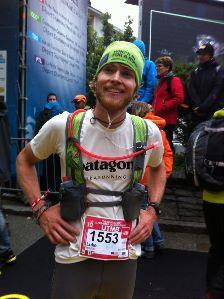
I will definitely be going back, I need to run the whole course!
Q: What is your main competition sport – skimo or mountain running? Do you favour one over the other?
I would say that both skimo and mountain running are equally important to me. They both require a significant amount of training and dedication, but they complement each other nicely.
I find that switching sports in the fall and spring brings a new found motivation and excitement for the change in pace. In the winter I feel like my body gets a break from the impact of running trails all summer, without losing the fitness that I work so hard at maintaining.
Q: Do you need to specialize a lot once a specific season starts?
I tend to do longer races during the running season so there are some subtle changes to the training program that help switch the pacing gears a little.
I do spend a fair bit of time practicing transitions early in the skimo training cycle, but that would be the only thing that is very different between the two.
Q: When have you started and what made you try ski mountaineering racing?
I started skimo racing 6 years ago. I joke that I didn’t find skimo racing, but rather it found me. It is kind of a long story how I evolved from a semi-pro snowboarder, to ski guide.
The winter I was working as a guide I spent a lot of time touring and the more I toured with other folks I found that I was moving at a different pace. One day some friends mentioned that there was a “rando-race” coming up and that I should go to see how I measure up against the “mutants”. I didn’t think twice before signing up. The race was the US Skimo Champs in Jackson Hole, I think I placed 14th on pretty heavy touring gear. I was completely hooked after that one race.
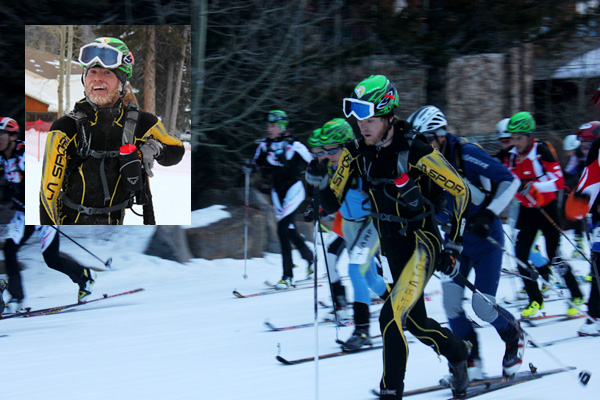
I grew up in a very outdoorsy house. I started climbing and hiking when I was really little, I actually climbed competitively for several years, mostly at indoor gym comps. I played soccer from when I was about 8 until just after my 15th birthday.
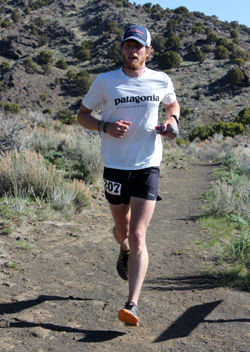 Mountain sports took the priority from there on and I spent the next several years climbing, kayaking, and snowboarding. On a whim I ran cross-country my senior year of high school, mostly because the coach, my biology teacher, invited me to try out. I ran OK, but didn’t have the depth I needed to be very competitive.
Mountain sports took the priority from there on and I spent the next several years climbing, kayaking, and snowboarding. On a whim I ran cross-country my senior year of high school, mostly because the coach, my biology teacher, invited me to try out. I ran OK, but didn’t have the depth I needed to be very competitive.
After high school I had a stint as a semi-pro snowboarder, during which I spent a lot of time also climbing and kayaking. I graduated with a degree in Outdoor Education and transitioned into guiding.
During my first season working as a guide the company I was working with asked if I could guide on skis instead of a snowboard. So I spent the next couple of weeks learning how to ski when I wasn’t guiding. I finished off the season guiding on two boards instead of one. That was the same season I tried skimo for the first time.
Ironically, I decided to train for skimo racing that following summer by trail running. It turned out that I was a pretty solid runner and by the end of that summer I won the first 50k ultra race that I entered. Since then I have continued to run and race skimo, both of which I now do at a very competitive level.
I still enjoy climbing, and snowboarding. I don’t kayak much anymore because of too many close calls.
Nowadays I spend more time hiking with my two daughters, as well as taking them climbing and skiing.
Q: How do you manage being a father, husband, athlete and work?
Sometimes I ask myself the same question. I think the most important part is how supportive my amazing wife is. Tanae really helps me find the time I need to train and puts up with a lot.
I think that managing time is really important and making the most of training time. Cut the junk and train at a quality level whenever you are out. Sometimes training becomes a family activity. Both of my daughters have spent countless hours being pulled or pushed in our Chariot. I have ran, skied, roller skied, biked, and hiked with them. They seem to enjoy the adventure as much as I enjoy the added challenge to the workout.
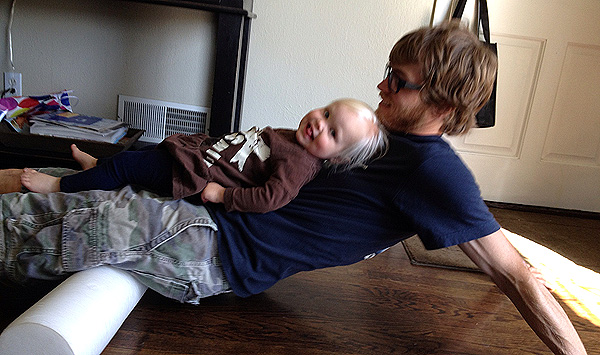
I now have a couple of folks involved in developing my training programs to make sure I am getting the most bang for the buck. Adam St. Pierre from Boulder Performance Medicine is working with me to plan out my skimo and ultra-training and I am supplementing that with an awesome strength training program from Rob Shaul at Mountain Athlete in Jackson Hole.
Adding Adam and Rob into the equation was difficult at first because I had done all of my own training up until the summer, but I am already seeing the benefits of their additional focus.
Q: Do you have any sponsors to help with the expenses?
I am very fortunate to have a handful of outstanding sponsors. For trail running I represent Patagonia, First Endurance and Ultraspire. I am a Ski Ambassador for La Sportiva in the winter.
I do receive help with travel, and lots of help with product needs. I am very thankful for their support.
I think it is interesting that in a 9th grade high school career planning class we were asked to write what we wanted to do when we “grew-up” and I wrote that I wanted to be a climber for Patagonia and travel the world climbing so I could have my picture in the catalogue. Funny how it turns out that I am doing what I dreamt of. 🙂
Q: In 2011, you went to skimo World Champs in Italy. What was the experience like for you?
Intimidating.
I had been training super hard and I knew that I would finish mid-pack at best. It was so amazing to be lining up at the same start of the guys who I really look up to in the sport; Kilian, Manfred, Stephane, and many others. I spent as much time as I could learning about the sport from them, mostly by watching.
I was lucky enough to be adopted by a few of the Canadian Team members early on, which also gave me the opportunity to learn quite a lot from them.
Q: Are you going to race in Europe this year? And what are your goals?
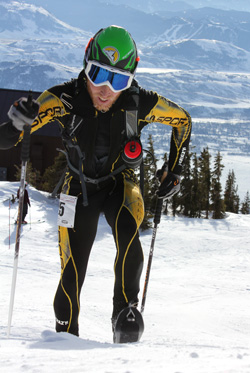 My biggest goal of the season is to qualify for the US team so I can go to race at the World Championships in France.
My biggest goal of the season is to qualify for the US team so I can go to race at the World Championships in France.
I would love to defend the US national title, but there are so many strong racers in the US right now, that is going to be very difficult. I am also planning on racing the North American Champs at Kicking Horse Resort (Golden, BC), as well as heading to the three day Powder Keg event in the Wasatch.
The more I compete in skimo and mountain running the more I enjoy the training for the events. So apart for doing well in races I would say a very big goal for me is to enjoy the journey towards the big events.
Q: If you are racing World Champs, which discipline is your favourite and why?
I think that is a tie between the teams race and the individual event. I like that both of them are longer races and tend to be more technical.
I really enjoyed the Teams race in Italy, when I got the privilege of being paired with Pete Swenson. So much of ski mountaineering (outside skimo) is being with a partner, having a partner in the teams race makes it more real to me.
Q: According to you, who are five US guys to watch for this skimo season?
Jason and Andy Dorais, Marshall Thomson, Scott Simmons, and either one of the Graston brothers from Aspen are all going to be very strong. There are a handful more that will also be in the mix. It will be the most competitive season I have seen here in the US.
Q: A curiosity question: As someone working in the field of medicine you have great knowledge of human body. Can you describe from a physiology perspective what is going on in an athlete’s body when they hit the wall (by pushing hard)?
I haven’t studied a ton on the physiology of the “wall” but I think there are multiple variables that come into play. I think there is a lot of credibility to the Central Governor Theory presented by Tim Noakes, which in a nutshell describes that the brain creates a barrier that is designed to protect you from yourself.
My addition to that would be that the harder and more consistently one trains, that barrier can be moved allowing the athlete to break barriers and go faster and further than before.
Certainly there are many biochemical reactions that come into play including the clearance of lactic acid and muscle breakdown, but those can also be trained and made to be more efficient.
Q: Do you do any specific skimo racing session? What do you think prepares one best for demands of skimo racing?
I generally make a transition from run training to skimo around the end of September. This year I took a couple of weeks off after UTMB and then spent a few weeks just strength training.
Now I am working on a skimo specific training plan that includes trail running, roller-skiing and a few other top-secret activities. As with any sport skimo racing is the best prep for skimo racing, but since we all can’t race all the time like the Euros, you have to train like you would race!
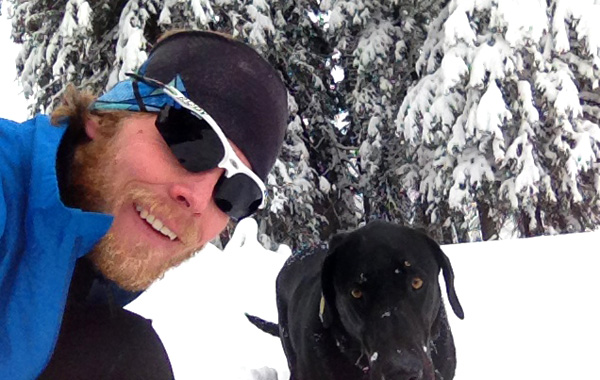
I try to eat pretty healthy and have recently been dabbling some with the Paleo eating philosophies. I try not to get too caught up in any one thing. I realized this summer that what I eat is what fuels me, and it does make a big difference if you are eating well. That being said, I still have a weakness for the occasional Wendy’s Hamburger.
Q: What skimo racing gear will you be on this season?
I will be head to toe in La Sportiva. They are introducing some new clothing and a new race suit.
For boots I have been racing in the Stratos boot for two seasons now and I am very excited to be in the latest version of that boot. I will be on the RSR skis and RSR bindings with the Sportiva Race skin.
I have been working on a new skimo race pack with the folks at UltraSpire so that will be what I will use to carry the rest of my kit around this season.
Q: I asked this while interviewing Janelle Smiley, now wonder about men’s perspective: How does it feel to be surrounded by a sea of men in tight, full-body spandex suits at the start of skimo races?
It makes me very nervous! Mostly because if a racer is serious and bold enough to be rocking the spandex suit it means that they have been training hard and it will be a battle to beat them.
Plus who wouldn’t be nervous being surrounded by a bunch of “mutants” in skin tight unitards?
» Make sure to also check out Luke’s blog
Skimo Racing
Janelle Smiley: Interview with the 2012 North American Ski Mountaineering Champion
Janelle Smiley is someone I wanted to interview for a long time now.
She can’t be simply described as a skimo racer despite the fact she is the 2011 US Ski Mountaineering Champion and 2012 North American Ski Mountaineering Champion. She has a bit more going on than that.
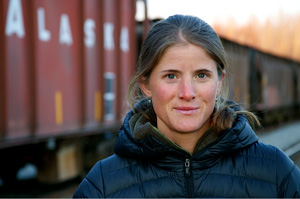 I don’t think we ever officially introduced but I first met her at the 2011 Skimo World Championships in Claut, Italy:
I don’t think we ever officially introduced but I first met her at the 2011 Skimo World Championships in Claut, Italy:
First, someone told me she was a mountain runner. That made sense as she was very fast.
Then someone else said she was a climber. Well, that didn’t make sense since I saw her transition at the end of a via-ferrata section during individuals’ race earlier that day. She was super slow but her style of climbing is absent of a via-ferrata.
» Janelle’s website – Smiley’s Project.
Q: You emerged onto the North American (and World) skimo racing scene in full force in the 2010/11 season. Was that your first season racing skimo?
The COSMIC series had just started in Colorado in 2007 I think, and there was a telemark division. The only pair of skis I owned at the time were telemark skis, so I went for it. I really enjoyed the races and I think I did all 5 that year.
I do remember being totally smoked after the first race, but the people with the lightweight AT gear were finishing the race and then going back up the lifts for more skiing! I thought those people were freaks of nature and never thought I would ever be racing at their level.
After two years of recreational racing I got my first pair of comparably lightweight gear. I didn’t do too many races that year because I was always missing some piece of equipment.
The following year I had a full setup, still 5+ lbs heavier than the freaks, but I was excited to have a complete setup. Someone said I should go do the race in Jackson, WY and since my brother just moved there I went. Honestly, to my great surprise, I gave it my all and won the 2011 National Championship. At the finish line I couldn’t believe it.
Soon after, I met Jonathan the President of La Sportiva and that was the start of my racing.
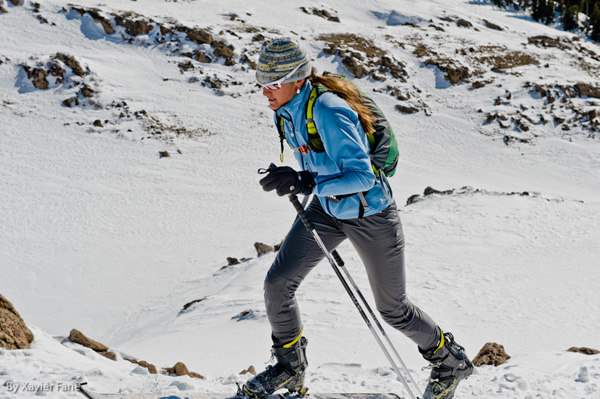
Q: You grew up in Colorado, so playing outdoors must have been your routine since a little girl?
My parents always encouraged us to play outside and go on adventures. I started skiing when I was 3 and it was always a part of my life, except during those rebellious years in high school when I snowboarded… Oh, and those trendy years in college telemarking. But now I am back skiing for good.
Q: Where do you live now?
A: Depends on the week… currently in my van.
Q: What is your sporting background? And do you have any other racing going on besides skimo?
In college, I rowed crew then transferred colleges where I dabbled in Nordic racing. I was never very good. Probably because that was the first time I put on Nordic gear by my own choosing, opposed to being forced by my Mom. I have been know to jump into a running or Nordic race every once in a while.
Q: You are also a climber, or are you a climber first? Do you define yourself by any one of your activities?
Well, I skied first, then started climbing, then started ski racing, so I guess that makes me a “ski” – “mountaineering” – “racer”. Yeah, that’s my favourite, but it can also be broken up into individual words and they are also my favourite. Depends on what season it is.
Q: You have a big on-going project in the works – together with your husband, you are climbing the 50 classic climbs (based on a book Fifty Classic Climbs Of North America). How that idea did come about?
My Husband Mark is crazy and doesn’t want our marriage to get boring. He had a friend who did 20 of them in 20 days and thought it would be fun to do all 50. When we started we didn’t realize what was involved to climb all these peaks. He just thought it would be a fun adventure.
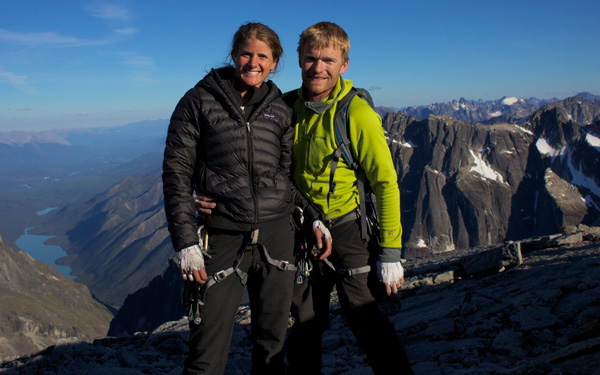
The project started in April of 2010.
We just spent our 6th anniversary 2500 feet up El Capitan in Yosemite, climbing the Salathé Route. That was #40 and we are really excited to be this far in the project after just 3 summers.
Q: Which ones so far were the most challenging? Any scary moments?
They all have their challenges, Mt Robson seemed to be the hardest one to get past the approach – it took us four tries to summit. The Petit Grepon is the hardest one to find (climbed the wrong tower), Mt Waddington was the most expensive so far and it was the scariest one too, many large loose blocks that wanted to take us out.
Mt Robson’s Wishbone Arête from Mark Smiley on Vimeo.
Q: Do you know any good climbing jokes?
How can you tell Santa is a climbing bum? He’s got a beard, always wears the same clothes, and only works one day a year.
Stano: That is a good one, and I never heard it before. Thanks. 🙂
Q: Back to ski mountaineering. In 2011, you went to skimo World Champs in Italy and have done quite well for a novice at that level. What was your experience?
The competition was great, made me work hard for it, but it gives me something to aspire to. Really looking forward to going back this year.
Q: What are your racing plans for this winter? Do you have any specific goals?
Some here in the States, then off to Europe to compete with the top-dogs. I do have big goals, but the biggest is to embrace the experience and enjoy the adventure.
Q: If you are racing World Champs, which discipline is your favourite and why?
I like the teams race, its fun to push it with a friend, I really like that dynamic and I have had great experiences with them in the past. The individual race is always fun too, but for different reasons. All you have to do is go as fast as you can and not eat it.
Q: How stressed or relaxed are you for races?
I race because it gives me life and pure joy, when it stops doing that I’ll move on. It’s too stressful to get too serious.
Q: Do you do any specific skimo racing training? Or you subscribe more to a formula “training through adventure”?
Well, funny you ask, it has always been “training through adventure” and I really resisted formal training until this year. I now have a coach and work with Mountain Athlete. I do what he tells me to, and its working well. It makes it easier to know what to do each day. We will have to wait and see the results to see if it worked.
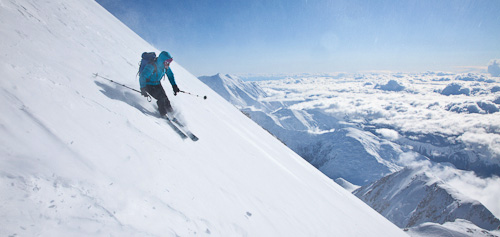
Q: What is your nutrition like? Do you follow any diet?
I love donuts, not just any donut but the donuts they make in Crested Butte. Cake with cinnamon, hmmm so good. But my stomach has been rebelling so now I go without dairy and wheat. Good thing I won’t be in CB this winter cause I would splurge for a donut.
I also really like Garden of Life products, they make me feel healthy.
Q: Any nutrition racing tips for others from your experience?
The key to success is to stay fueled and hydrated while racing. I put a gel in my water bottle that way I do both at the same time. I don’t have a dialed system, it is always evolving.
Q: How about gear. What will you ski on this season?
La Sportiva. Does anyone else make gear? Kidding, there are lots of great gear companies.
I use the La Sportiva Stratos boot, RSR binding, and RSR ski. It’s one sweet set up!
» Janelle might be one of the lucky athletes to test the new La Sportiva Stratos 3 Cube boot.
Q: Do you have any sponsors to support your adventurous life?
My entrepreneurial husband, La Sportiva, Gore-Tex, Nemo, Kaenon, Sterling Rope, Suunto, Garden of Life, Honey Stinger, Goal Zero, Rab, Family, and Feathered Friends.
Q: How would you motivate/inspire/engage more women to try skimo racing? Why the hell should one bother?
It is truly the best sport in the world, enough said. When this is all over, and I stop living in my van, I would like to start a junior team. I would love to see this sport grow. I think it is an empowering sport that builds discipline, strength and character.
Q: How does it feel to be surrounded by a sea of men in tight, full-body spandex suits at the start of races?
Like being in a can of sardines! 🙂
» For more info visit Janelle’s and Mark’s website – Smiley’s Project.
La Sportiva Stratos Cube – lightest skimo boot in the world!
A post about new La Sportiva Stratos³ Cube appeared here on Skintrack couple of weeks ago but had to be taken down on request from La Sportiva due to patent filing process. However, the info is back and much more detailed!
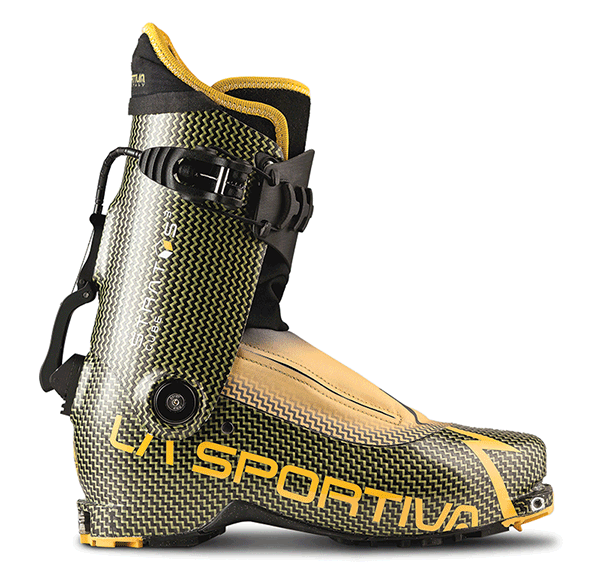
La Sportiva’s carbon lab is almost ready to reveal the Stratos³ Cube and here are some specs that should leave any light gear freak impressed.
La Sportiva Stratos³ Cube details and specs:
- Weight: 470g / boot at size 27 (without liner)
- There might be two liners available and the lighter one will weigh only 80g – Bikini Cube Liner
- Shell and Cuff material: 100% Carbon Kevlar
- Outsole: Vibram
- Range of motion: 76° (+53°, -23°)
- Forward lean: 5 positions from 5° to 19°
Combined – boot and liner – the weight comes to 550g per boot! This likely makes the Stratos³ Cube the lightest ski mountaineering boot in the world, surpasing Pierre Gignoux XP444 by few grams.
This 3rd generation of the Stratos boot will be ready for retail for Winter 2013/14, but there should be some top skimo racers testing it this season already.
» See this page for a full comparison of the current lightest ski mountaineering boots.
» And here is a video when the first Stratos boot was announced – New carbon ski boot: La Sportiva Stratos
La Sportiva Strato Cube photos
New Stratos Cube in action:
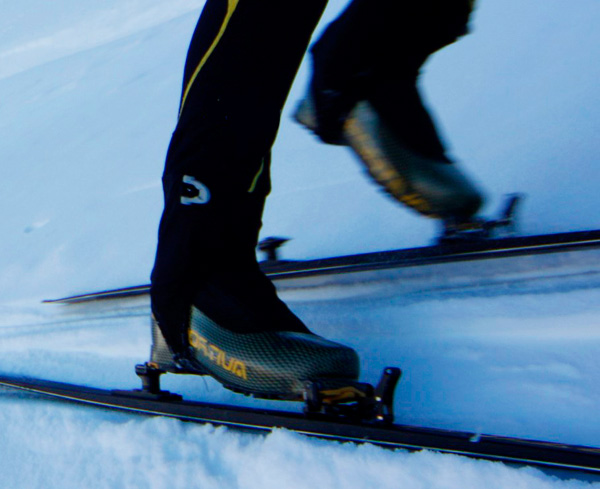
Stratos Cube Vibram sole:
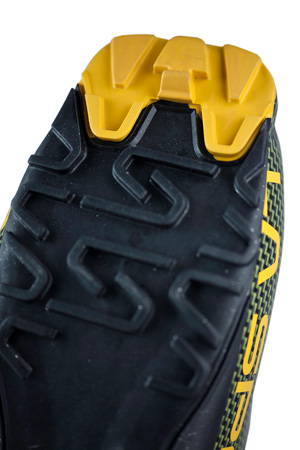
Continental Ski-Mo Championships in Golden, BC set for March 2013
The biggest ski mountaineering race in North America for the upcoming season found its home. Kicking Horse Mountain Resort near Golden, BC will host a skimo dedicated weekend on March 16-17, 2013.
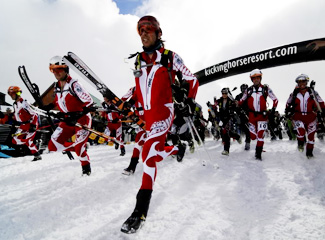 The official name for the event will likely be “The Dogtooth Dash- 2013 Continental Ski-Mo Championships” but some details are still in the works.
The official name for the event will likely be “The Dogtooth Dash- 2013 Continental Ski-Mo Championships” but some details are still in the works.
If you have never skied at the Kicking Horse Mountain Resort here is your chance to race over its amazing terrain that tests Canadian skimo athletes each year during the annual Canadian Ski Mountaineering National Championships.
More details will be made public in the near future. In all previous years the course was beautifully designed by Ian Gale, the angry one in the photo.
For reference, here is a short edit from the 2011 two day event:
ISMF White List: List of approved equipment, clarification… and some confusion
As we were busy researching gear for comparison pages of the lightest equipment the last couple of weeks – skis, boots and bindings – the International Ski Mountaineering Federation (ISMF) was busy creating a list of gear that would be approved for racing. They labeled it the ISMF White List.
Show me the White List
Unfortunately, due to the way the ISMF website is built there is no unique link to any page on their site, same goes for White List.
Therefore, to browse the White List go to ISMF home page and in the middle column you will see a banner that will point you to the right page.
The navigation through the White List is somewhat confusing, so be patient and forward thinking 😉
Clarification
People that studied the latest version of the ISMF competition rules (for 2012/13 season) know that there are some grey areas that create confusion about whether a certain piece of equipment would be in fact legal at an ISMF sanctioned event.
On top of that, the White List doesn’t seem to include some big names at the moment, for example Dynastar and Pierre Gignoux are not there.
With curiosity I emailed ISMF directly my questions:
Thank you for the information on the newly created equipment white list. And hopefully you can clarify something for me.
I own and are planning to buy some equipment that is not currently on the “white list”, so I want to ask:
If equipment is not on the white list does that mean it is illegal for ISMF sanctioned competitions (such as World Cup)?
What about Dynastar skis or Pierre Gignoux boots (those brands and their equipment are not on the white list), will you allow me to compete with that equipment?
Does a company have to be part of the manufacturers’ pool in order to make their equipment legal, put on the white list?
I got an answer yesterday which is actually almost identical with what they just clarified on their website (home page banner). But they clarified even further which I thanked them for.
ISMF response (interesting in red):
“The ISMF White List is a list of products all relevant to competitive ski mountaineering – provided by various manufacturers which are member of the ISMF Manufacturers’ Pool. Each product is self-certified by the manufacturer to fit within ISMF Sporting Regulations. Therefore when a skier looks at the ISMF White List he/she knows that the products are suitable for use in ISMF races. Items which do not feature in the list are not necessarily outside of the guidelines, it’s just that the manufacturer has chosen not to participate in this initiative, therefore the validity of products not listed should be checked directly with information provided by the manufacturers. In any case the equipment used in ISMF competitions must comply with the ISMF Sporting Rules.”
They added this bit for me:
“You can buy the brand you would prefer: the only important aspect is that if you would like to compete in an ISMF race the equipment should comply with the ISMF Rules.
The advantage of the white list is the fact that you have already a list of certified products, so you don’t need to ask to the manufacturers if the material complies with ISMF rules.”
Confusion still exists
I applaud the effort to put the White List together, it was long due.
However, by always referring to the rules, should one be in doubt, one will do so. The crux is that the rules aren’t crystal clear about bindings, specifically the release functionality – no specs are provided/required – leaves room for self-interpretation.
And with essentially manufacturers self-submitting (certifying) their equipment into the White List they must have figured that as long as a binding has a release mode it’s good enough.
Does anyone actually know what is OK-ed by the rules?
Have an opinion on rules around bindings?
With the above I wanted to help you clarify some things, and at the same time provide my opinion that there is still some confusion existing. To me, based on the rules, it’s not clear what a “safety release system” means, thus it leads me to assume that as long as the binding releases it’s legal.
Quoting from ISMF rules, section about bindings (regarding toe is in red):
“which allow heel movement during ascents and are blocked for descents;
front and rear parts:
• The rear part of the bindings must have front and lateral release safety systems.
• If front bindings have limited or no release safety system or can be used locked without a safety
system, it must be clearly specified in the written information supplied with the equipment that these
bindings are designed for competition and don’t require a safety release system for the front part of
the bindings.
It is recommended to use a safety release system in the front part, which will be compulsory
from the season 2012-2013.
For the season 2012-2013, a minimal distance of 4mm will be imposed between the rear part
of the boot and the heel piece.
(NB : ski stoppers are no longer compulsory for the 2013-2014 season)”
What do you make of it?
Canadian team summer skimo training camp – Revelstoke, Sep 15-16, 2012
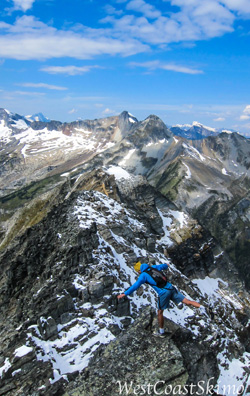 Since 2009 Canadian National Ski Mountaineering Team have been meeting every September for our summer training camp.
Since 2009 Canadian National Ski Mountaineering Team have been meeting every September for our summer training camp.
Previous camps were usually hosted in Canmore, AB by Steve Sellers but this year we thought it’s time for a change and organized it in Revelstoke, BC.
The team was pretty much complete with one exception – everyone’s favorite and North America’s fastest, Reiner Thoni, couldn’t make it as his old truck started to come apart a day before his departure.
Camp concept
The idea behind this camp wasn’t about training hard. It was about getting together and have good times.
We are also trying to blend in some younger blood into the team before people find themselves sharing a room at World Championships in February, 2013.
Attending: Melanie Bernier, Martha Burley, Steve Sellers, Stano Faban, Brad Schalles, Peter Knight, Adnrew McNab, Ian Gale, Jeff Colvin, Julie Matteau.
Day 1: hiko-running-scrambling Mt Cheops (2605m)
Summary of day one and all photos are from Brad Schalles (WestCoast Skimo – http://westcoastskimo.blogspot.ca/), one of new additions to the Team. Watch out for Brad this year, he will be the NA dark horse this year.
On Saturday the group split up, with five of us heading up to Rogers Pass for a run and scramble up 1300m to summit Mt Cheops. After meeting up with Steve, who had spent a cold night at the pass, we headed up the trail in the crisp morning air.
The run up to Balu Pass was fast and we all felt light on our feet on the superbly maintained trail. We made it to Balu in an hour and thirty minutes – we all remarked on how much faster it was to run up the valley rather than ski.
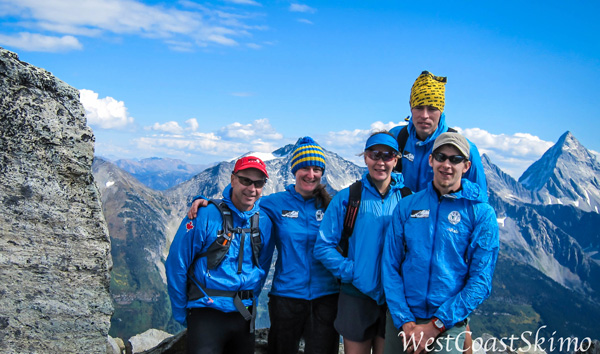
We made a light-speed trip back to Revelstoke (thanks to Slovakian over-drive), and we regrouped at a fine local establishment with Andrew and Peter. They had spent the day at the Martha Creek Melt Down where Peter placed 1st and Andrew 4th. After a great night caching up and talking all things skimo, we headed home to rest up for the next big day of the camp.
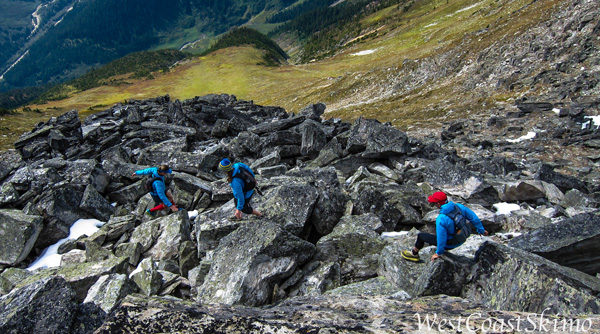
Day 2: Skimo pentathlon + bike ride
Watching the summer London Olympics left me with lots of inspiration and so on Sunday morning we all met at Revelstoke high school stadium. The leader for this session was Jeff Colvin – one of the fastest Canadian skimo racers few years back – who is a track & field coach at the school.
Under Jeff’s leadership we all completed the following “skimo pentathlon”:
- 100m sprint
- shot put
- star run (agility run)
- long jump (from stand-still)
- 800m run
Everyone had loads of fun as none of us knew what to expect from each discipline. On top of that, by the time our heads somewhat grasped one skill it was time to move to something else – testing our adaptiveness in the process.
Women’s pentathlon was won by Melanie Bernier and men’s main prize went to Brad Schalles who blew everyone in the 800m run on top of winning the 100 dash.
» Revealing video coming soon 🙂
Afternoon
After a season planing meeting during the lunch we split into road and mountain biking groups.
In fact, it was only me and Brad riding the road. We had a good 3h ride in the sunset lit valley north of Revelstoke, riding the always twisting road on the shores of 130km long Lake Revelstoke.
The mountain bike group rode the shadowy side of the valley, however, great Revelstoke trails kept them warm too.
Next camp
Team’s next camp is in the works. It will likely be already on skis somewhere high in the beautiful Canadian mountains.
Steve Sellers interview: Skimo racing is the ultimate skiing challenge!
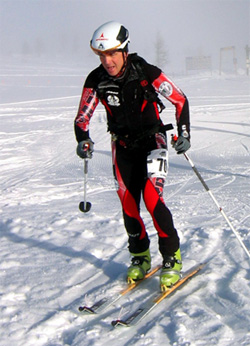 The world of ski mountaineering racing is full of unique characters, and arguably the Canadian and the American skimo scenes are responsible for bringing the most flavour in recent years. This translates to the national teams as well which makes the North Americans’ Euro racing trips very enjoyable.
The world of ski mountaineering racing is full of unique characters, and arguably the Canadian and the American skimo scenes are responsible for bringing the most flavour in recent years. This translates to the national teams as well which makes the North Americans’ Euro racing trips very enjoyable.
But there is one character that I feel I neglected with my interviews for way too long. He is a die-heart competitor to whom age seems to only provide with more speed, in fact, he is on the Canadian National Ski Mountaineering Team.
Steve is a father of two and a pastor in Canmore, Alberta. At the age of 51 he just recently captured bronze at the Canadian skimo nationals!
Personally, I am very happy to had the experience to witness him to give a true 120% in our teams race at the 2011 Worlds. It was inspirational to be part of it – one can always improve.
» Check out Steve’s blog – Ski Training Central
About training, longevity and racing passion with Steve Sellers:
Q: Steve, what do you find the most beautiful and the most challenging about skimo racing?
Skimo racing is the ultimate skiing challenge! You have to have the motor of an xc skier and the athletic ability of a downhill racer. With my xc background the obvious weak link for me are the downhills (as you Stano probably painfully became aware of in our teams race in Claut, Italy!). [Stano’s note: I remember very vividly :)]
To rectify this I go to Norquay ski area in Banff at least once per week with my lightweight race gear and hammer the double blacks off the North American chair. I time myself and try to improve every run.
It’s the challenge of getting better that keeps me motivated in this great sport.
Q: When did you start skimo racing? And for how long have you been backcountry skiing?
In 2007. That year my focus was on fulfilling a dream of cross-country (xc) ski racing the famous 90km long Vasaloppett in Sweden. Just prior to leaving I jumped in the ski mountaineering race at Sunshine. On the heavy gear I wasn’t too fast, but I was easily hooked. I just felt it would be the sport for me.
Later that year, I found myself in Vancouver for a conference the same week as the North Face Whistler skimo race and decided to do it. Everything seemed to go wrong and it was a total disaster, but deep down I felt like I could do this sport. I decided then and there to go back the next year and prove to myself I could do skimo racing. I finished 4th or 5th and knocked a couple of hours off my time.
Q: What is your racing background – which sports, for how long?
I started xc ski racing in high school. Living in Minnesota at the time there wasn’t very much downhill or backcountry skiing to be had so I totally poured myself into xc.
I really loved it. I even got to represent the US in a world cup in 1985.
My main focus each year though was the US Birkebeiner. I competed in the elite wave from 1980 to 2010.
Q: You also race Ironmans and shorter triathlons in the summer. When do you switch from winter to summer training and then back again?
After 20 years of roller skiing and running in the summer, among other dry land training, I figured it was time for a change.
For a long time I had on my Bucket List: “competing in an Ironman”. It seemed like the clock was ticking, so I thought I’d better go for it. I did half-Ironman and Olympic triathlons for 4 years, then finally got into the big one, Ironman Canada.
Interestingly, my ski results got better. I think it was the extra endurance base hours I was putting in, plus the new knowledge I’d gleaned from training and competing at a whole new level.
I’ve since found that for my best winter results competing in this totally different sport really works. But it also works the other way around. Two years ago I placed 3rd in my age group in the Calgary Half Ironman and qualified for the world age group championships. I was kind of surprised since due to our usual long ski season and a trip to Europe I’d really only tri-trained a month or so.
However, on the ride home as I shared these thoughts with my wife she mentioned, “that skimo racing is pretty tough, that’s probably why you did so well.”
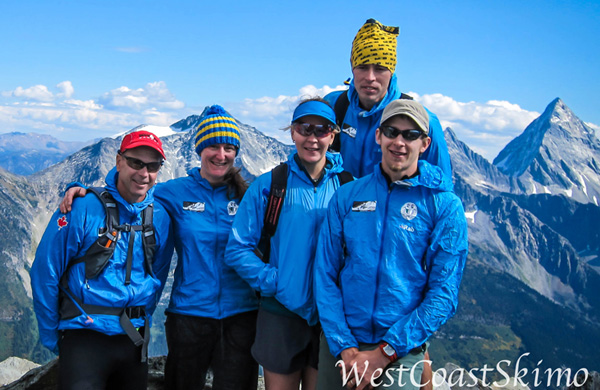
After an Ironman you’ve gotta take about 3 weeks off. The first one you don’t even want to train. The second one you can’t even if you want to, then the third you can start easing into activity.
I take about 4 weeks of easy training after the skimo season too. I’m still skiing 6 days a week (the skiing’s too good to sit around!), but absolutely no intensity.
During the year you have to build in rest days. If I train 3 weeks uninterrupted (hard to do with a job and family though), then my body makes me take that 4th week easy.
Q: What do you think is the secret to your longevity in competition sports? How can someone copy you?
The heart’s gotta be in it. You’ve also gotta be in it for the right reasons.
Sport was never designed to be a place to get your self-esteem needs met. If you’re just competing because you have to prove to yourself and others you’re a worthy person, then you’re just chasing after air.
When you’re secure in yourself as a person, at peace with your Creator and have family and friends that love you and support you, then you can be at peace to pursue your passions.
Q: You are always keen to compete. What keeps you motivated?
I’d say the key for me is improvement. If there’s the possibility to get better then I find that a fun challenge to take on.
After last year’s Canadian Nationals at Kicking Horse ski area, I identified 6 areas I felt I could get faster in (transitions, downhills, uphill fitness, kick-turns, boot-packing and skin speed). I also estimated how much time I could realistically gain from each.
From there I started working on each individual area. I’m still doing it. I’ve got a cool summer ski sprint course I grass-ski on to work on transitions, boot-packs, kick-turns and uphill sprint speed.
Q: You have two daughters, Anna and Kjirsti. Are they competing in sports too? Does ski mountaineering potentially interests them?
Anna did her first skimo race last year as part of our team relay at the Vert 180. She also had 2 biathlon and 2 xc ski races that weekend. It was hard for her to choose which ones to do. She’d do all of them if we’d let her.
My other daughter cries when she has to go downhill skiing with the family but she’s a pretty good skier anyway. Like her older sister she’s involved in the Canmore Nordic ski club.
With kids you gotta let them find their own path. We give them the opportunities but I want them to show some initiative on their own to pursue what their heart leads them to.
Q: You represented Canada at the 2011 World Ski Mountaineering Championships. How did you find the experience?
Simply put…amazing! I don’t think there is a greater privilege in sport than to represent your country, especially at the highest level.
During the warm up before our teams race I started feeling the nerves coming on and thinking “how in over my head I was”. Then I began to contemplate how truly blessed I was just to be there, representing Canada, my country.
This realization just filled my heart with joy. Joy is such an energizer in so many ways. I think too that my walk with God brings joy and energy to these moments.
Q: Do you have plans to race at the 2013 World Championships? Or what is going to be your biggest goal for this winter?
I’ll admit I was a little embarrassed being the “grandfather” of the 2011 championships; however, I seemed to make a bit of a jump in performance last year. As long as I’m improving I may as well throw ‘er down with the big boys and see what I can do!
Q: With so much experience in competition sports, what would you advise to ambitious skimo racers in North America?
One thing I absolutely love about our Canadian skimo team is that we work together. Having a “win-win” philosophy benefits everyone.
The sport is so young in both the US and Canada and we have so much to learn. We might as well help one another as much as possible. That way we’ll all get faster sooner!
25min documentaries from Pierra Menta 2012 and Tour du Rutor 2012
Every two or three years we get great documentaries that capture the beautiful essence of our sport. Usually, they are from skimo’s two biggest stage races – Pierra Menta and Tour du Rutor.
Find half an hour on two evenings and make sure to watch these two. They are full of in-action shots, aerial footage and interviews. There is one hook though, they are in French.
Pierra Menta 2012 – 25min
If you don’t have time for the whole clip then just watch only 20 seconds – from 16:30 to 16:50 – and you will breathe the amazing atmosphere.
Tour du Rutor 2012 – 27min
5 important things: New ISMF ski mountaineering competition rules for 2012-2013 season
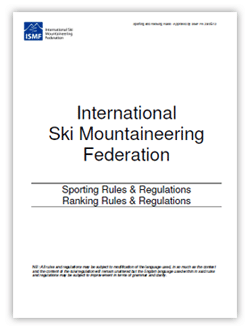 This is a brief look at some important points and changes that you can find inside the recently approved (June 23, 2012) ISMF ski mountaineering competition and ranking rules for the 2012-2013 season.
This is a brief look at some important points and changes that you can find inside the recently approved (June 23, 2012) ISMF ski mountaineering competition and ranking rules for the 2012-2013 season.
Here is a PDF of the full document – 2012-2013 ISMF Sporting and Ranking Rules.
This document mostly affects only those planning to race at ISMF sanctioned events such as World Championshisps, World Cups, or other ISMF certified races.
Overall changes
Understandably, majority of rules and regulations stayed the same as they have strong basis.
However, many new small changes helped to simplify and clarify the interpretation of specific rules, therefore, removed lots of “grey areas” from the whole document.
5 most important things inside the new rules
1. Race lengths – more specialization
Comparing to the previous regulations version, the vertical races will be shorter for all categories. Now:
- for senior and espoir men and women they are set at 500 to 700m (vertical gain)
- younger categories will race 400 to 500m
Individual races will get longer compared to the past. Most importantly:
- for senior and espoir men they will be now 1600 to 1900m
- for senior and espoir women 1300 to 1700m
Team races will get longer too:
- for senior men it will be at least 2100m
- for senior women at least 1800m
Sprint and relay courses will stay about the same.
Personally, I believe this is a change for better:
Ski mountaineering races shouldn’t be sprints if we want them to stay true to their roots. On the other hand, shortening the vertical is fine as it never really was a traditional skimo discipline, and now will provide one more race to seriously focus on for the explosive types.
2. Equipment minimum weights – unchanged
The skis+bindings and the boots minimum weight regulations stay unchanged. Therefore:
- ski-binding combo is still at 750g (1500g/pair) for men, and 700g (1400g/pair) for women
- boots are at 500g/boot for men, and 450g/boot for women
3. Required (compulsory) equipment – simplified
There should be less confusion of what is required for each type of race from now on as the ISMF simply made one list of compulsory equipment that will be the same for all races. Obviously, some additional equipment (crampons, headlamp…) might be necessary if conditions ask for it.
4. Points system changed – simplified
The points system for World Cup and World Championships races changes from “race time points” to “fixed points”. This means the points will be determined only by your finishing position and not by time lost to the race winner.
Personally, I like the old system because I believe it gives a better picture of racer’s performance over a long period of time, just like the cumulative time from all stages at big cycling races. However, I understand that it is some times difficult to explain to wider public how they are calculated, so a simpler version might be better.
5. Penalties – DQs simplify things
In the past, time penalties for lots of rule infractions (skiing where not supposed to, equipment weight…) were defined between 1 to 5min penalties (all the way to disqualification). The new rules introduce lots of out-right DQs.
The new DQs make a lot of sense and should have been introduced sooner because how can anyone say that “a lighter ski gives only such and such advantage, so lets penalize it with 3 extra minutes.” Now, if the minimum weight rule is infringed it is a simple DQ, the racer knew all along what he was doing.
Planning to race in ISMF events?
If you are planning to participate in races where these rules will be effective then I encourage you to read the whole document as you don’t want to be sent home from the start line.
Also, only if you know the rules you can mentally note an infraction by another competitor/team during a race and file a protest at the finish. Or successfully defend yourself.
Hiko-run: Skimo racer’s best summer friend
In the previous article on rando skimo racing summer training I talked about “bread and butter” – the benefits and importance of endurance base building during the summer months for ski mountaineers that absolutely want to improve their performance once the country turns white.
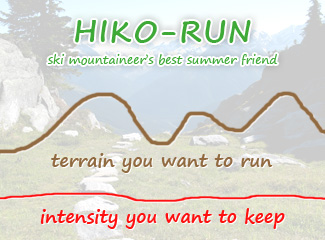 Here, I am going to discuss a workout that tremendously helps with building your endurance base while making you practice almost the same movement as on skis by working the same muscles as used during skinning.
Here, I am going to discuss a workout that tremendously helps with building your endurance base while making you practice almost the same movement as on skis by working the same muscles as used during skinning.
I have been using this type of a training session long time ago but only years later I started to fully appreciate how many benefits are packed into it, and it’s not all only about your lungs.
What is a hiko-run?
The term “hiko-run” is made up. I never heard it before I and a couple of friends came up with it. But it’s possible other people use it as well.
The need for such a term came from not being able to describe “a run that also featured walking parts” – our training diary was asking for something simpler.
Why you should hiko-run
Our small training group (back then I was a triathlete) never intended a running session to have walking segments but when, for training variety reasons, we wanted to run trails with long climbs while still remaining at low intensity (base building) we had to switch to a walk, or a hike mode.
In order to stay aerobic [Wikipedia link] on the lower spectrum of exercising heart-rate intensity for long periods of time our coach wouldn’t let us run over the hills. And so the “hiko-run” became a new term and a training tool.
You might be asking why one wouldn’t want to keep running even over small hills, no longer than 2-3min?
Well, even such a small hill can take you from low aerobic endurance intensity up to somewhere below your anaerobic threshold [Wikipedia link]. See also anaerobic exercise on Wikipedia for more details.
Now you maybe ask “why is this not desirable?”
Let’s say there were 10 such hills during your run and you sort of powered over them. With that you almost completely changed the goals/effects of that training session. I am not saying you should never run over the hills, I am saying that you should be quite mindful during every session to achieve desired training effects in the long term.
You can keep running over these hills right from June or July if you simply want to, however, you will be doing something that would have greater benefit on your performance if you introduced it few months after you built up a solid low intensity endurance base.
For the sake of simplicity I am going to stop discussing the physiology whys and whens right here as it might confuse less experienced ones. If I answer another why then I would have to answer many more whys and whens to fully explain this 😉 but feel free to ask in the comments below or email me.
Hiko-run with ski poles
Apart from a great exercise this session usually means beautiful trails and views as it is basically hiking with poles with a slightly longer stride.
How to do it properly:
Pick an objective (a mountain) with enough vertical gain that will have you climbing for at least 30min, doesn’t have to be very steep. I do anywhere from 40min to 2-3h. All depends on terrain available, your fitness, and goals.
Throughout the whole session try to stay in the endurance base building intensity – more or less being able to carry a conversation:
- On steep parts ease off the pace to compensate for the more challenging terrain thus keeping the intensity low.
- On flats, if it’s getting too easy, switch to jogging without using your poles – grab them in the middle for more comfort.
- All you are trying is just to maintain a low but constant intensity.
Experiment with frequency and length of your stride and because you will have poles you should use them to push off like when skinning thus getting a slightly longer stride. And remember to use hand straps.
To allow for a full arm extension your poles will need to be about 5-10cm shorter than what you use for touring or skimo racing.
>> See this article to figure out the best length for your skimo racing poles.
Benefits:
The main benefit to me is the relaxing energy of nature, and that you can do it with slower friends as the goal of the workout doesn’t require you to hammer away, or to unconditionally focus only on yourself.
Physiological benefits are:
- Endurance base building – increased aerobic capacity
- Increased leg strength because of the vertical gain
- Refreshing your muscle memory with skimo specific workout yet not requiring snow
- Downhills train your quads for non-stop skimo descents…or pool parties 😉
Hiko-run without poles
Hiko-run without poles is pretty self-explanatory but there are some differences compared to the pole version. Mainly, there is more running than hiking. I guess it could be coined then as a “runo-hike” 😉
This version can be used as a starting point if you don’t feel strong enough to sustain long climbing yet, or simply as a variation in your training whenever throughout the year – that’s how I use it.
How to do it properly:
Choose a trail/course that has some small hills. Adjust the vertical gain and length as desired. I do anywhere from 40min, when pressed for time, all the way up to 3h of total climbing time.
Again, during the whole session try to stay in the endurance base building intensity – on the hills ease off the pace to keep the intensity low. Since the vertical gain isn’t very much you should be able to run the flats while staying at low intensity. Downhills are up to you, I usually jog them but sometimes switch to walking if my legs feel too sore.
Stride length and frequency is very individual and I would advise to consult some experienced runners on this. My general advice would be, rather keep the frequency higher and stride shorter than the other way around. But mainly, just run and don’t worry much.
Benefits:
The main benefit is that you can quite comfortably cover lots of ground fast yet not be as sore the next day as if you run it. And the base building benefit is still there.
Physiological benefits are:
- Endurance base building – increased aerobic capacity
- Leg strength improvements are smaller but that is not the goal of this session anyways
- Your stride frequency is faster than when on skis (hiko-running with poles) which sets you up for a faster turnover once going into the winter
Hiko-run as a year round training tool
I believe it is beneficial to keep hiko-running or simply running even in the winter:
- Firstly, to break the training stereotype but
- more importantly, to exercise at a fast stride frequency (cadence/turnover) that could be maintained on skis only with very taxing high intensity intervals.
Sometimes I don’t run for couple of weeks during the winter because simply there is too much snow everywhere except paved roads, which I don’t like. However, when I get a chance to squeeze in a run even once in 10 days I can feel that my legs sort of “correct their timing” a bit.
Any questions?
If you found this article helpful tweet it, or share it with friends that can learn from it.
And feel free to ask anything in the comments below.

